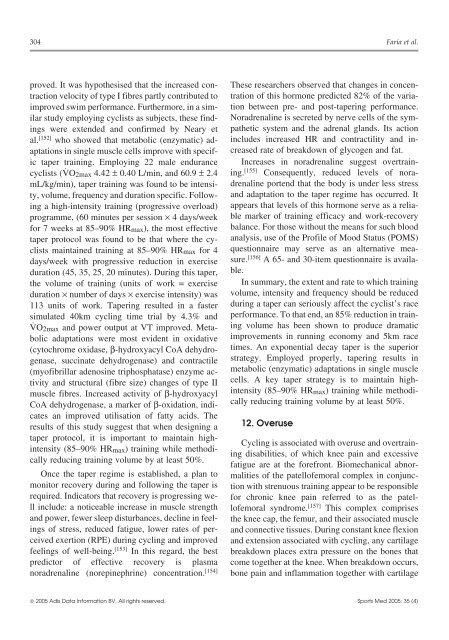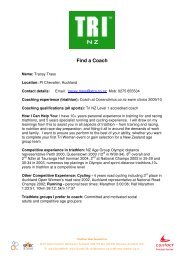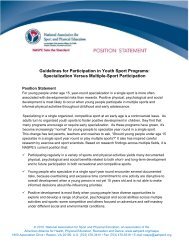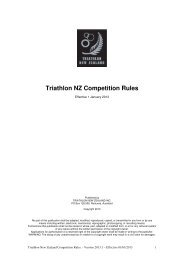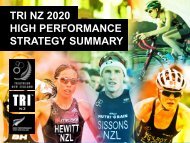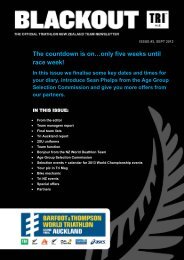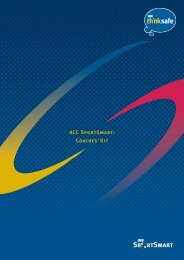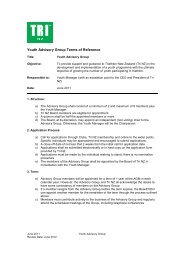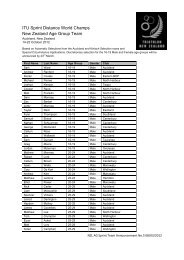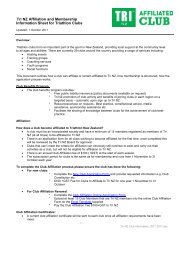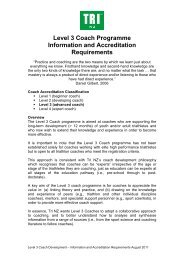The Science of Cycling - IngentaConnect
The Science of Cycling - IngentaConnect
The Science of Cycling - IngentaConnect
Create successful ePaper yourself
Turn your PDF publications into a flip-book with our unique Google optimized e-Paper software.
304 Faria et al.<br />
proved. It was hypothesised that the increased con- <strong>The</strong>se researchers observed that changes in concentration<br />
traction velocity <strong>of</strong> type I fibres partly contributed to<br />
<strong>of</strong> this hormone predicted 82% <strong>of</strong> the variatraction<br />
improved swim performance. Furthermore, in a sim- tion between pre- and post-tapering performance.<br />
ilar study employing cyclists as subjects, these findpathetic<br />
Noradrenaline is secreted by nerve cells <strong>of</strong> the sym-<br />
ings were extended and confirmed by Neary et<br />
system and the adrenal glands. Its action<br />
al. [152] who showed that metabolic (enzymatic) adcreased<br />
includes increased HR and contractility and in-<br />
aptations in single muscle cells improve with specific<br />
rate <strong>of</strong> breakdown <strong>of</strong> glycogen and fat.<br />
taper training. Employing 22 male endurance Increases in noradrenaline suggest overtraincyclists<br />
( ˙VO2max 4.42 ± 0.40 L/min, and 60.9 ± 2.4 ing. [155] Consequently, reduced levels <strong>of</strong> nora-<br />
mL/kg/min), taper training was found to be intensiand<br />
drenaline portend that the body is under less stress<br />
ty, volume, frequency and duration specific. Followappears<br />
adaptation to the taper regime has occurred. It<br />
ing a high-intensity training (progressive overload)<br />
that levels <strong>of</strong> this hormone serve as a reliaing<br />
programme, (60 minutes per session × 4 days/week ble marker <strong>of</strong> training efficacy and work-recovery<br />
for 7 weeks at 85–90% HRmax), the most effective balance. For those without the means for such blood<br />
taper protocol was found to be that where the cyquestionnaire<br />
analysis, use <strong>of</strong> the Pr<strong>of</strong>ile <strong>of</strong> Mood Status (POMS)<br />
clists maintained training at 85–90% HRmax for 4<br />
may serve as an alternative mea-<br />
days/week with progressive reduction in exercise sure. [156] A 65- and 30-item questionnaire is availa-<br />
duration (45, 35, 25, 20 minutes). During this taper, ble.<br />
the volume <strong>of</strong> training (units <strong>of</strong> work = exercise In summary, the extent and rate to which training<br />
duration × number <strong>of</strong> days × exercise intensity) was volume, intensity and frequency should be reduced<br />
113 units <strong>of</strong> work. Tapering resulted in a faster during a taper can seriously affect the cyclist’s race<br />
simulated 40km cycling time trial by 4.3% and performance. To that end, an 85% reduction in train-<br />
˙VO2max and power output at VT improved. Metaimprovements<br />
in running economy and 5km race<br />
ing volume has been shown to produce dramatic<br />
bolic adaptations were most evident in oxidative<br />
(cytochrome oxidase, β-hydroxyacyl CoA dehydrostrategy.<br />
Employed properly, tapering results in<br />
times. An exponential decay taper is the superior<br />
genase, succinate dehydrogenase) and contractile<br />
(my<strong>of</strong>ibrillar adenosine triphosphatase) enzyme accells.<br />
A key taper strategy is to maintain high-<br />
metabolic (enzymatic) adaptations in single muscle<br />
tivity and structural (fibre size) changes <strong>of</strong> type II<br />
muscle fibres. Increased activity <strong>of</strong> β-hydroxyacyl intensity (85–90% HRmax) training while methodi-<br />
CoA dehydrogenase, a marker <strong>of</strong> β-oxidation, indicates<br />
cally reducing training volume by at least 50%.<br />
an improved utilisation <strong>of</strong> fatty acids. <strong>The</strong><br />
results <strong>of</strong> this study suggest that when designing a 12. Overuse<br />
taper protocol, it is important to maintain high-<br />
<strong>Cycling</strong> is associated with overuse and overtrainintensity<br />
(85–90% HR max ) training while methodiing<br />
disabilities, <strong>of</strong> which knee pain and excessive<br />
cally reducing training volume by at least 50%.<br />
fatigue are at the forefront. Biomechanical abnor-<br />
Once the taper regime is established, a plan to malities <strong>of</strong> the patell<strong>of</strong>emoral complex in conjuncmonitor<br />
recovery during and following the taper is tion with strenuous training appear to be responsible<br />
required. Indicators that recovery is progressing we- for chronic knee pain referred to as the patelll<br />
include: a noticeable increase in muscle strength l<strong>of</strong>emoral syndrome. [157] This complex comprises<br />
and power, fewer sleep disturbances, decline in feel- the knee cap, the femur, and their associated muscle<br />
ings <strong>of</strong> stress, reduced fatigue, lower rates <strong>of</strong> per- and connective tissues. During constant knee flexion<br />
ceived exertion (RPE) during cycling and improved and extension associated with cycling, any cartilage<br />
feelings <strong>of</strong> well-being. [153] In this regard, the best breakdown places extra pressure on the bones that<br />
predictor <strong>of</strong> effective recovery is plasma come together at the knee. When breakdown occurs,<br />
noradrenaline (norepinephrine) concentration. [154] bone pain and inflammation together with cartilage<br />
© 2005 Adis Data Information BV. All rights reserved. Sports Med 2005; 35 (4)


